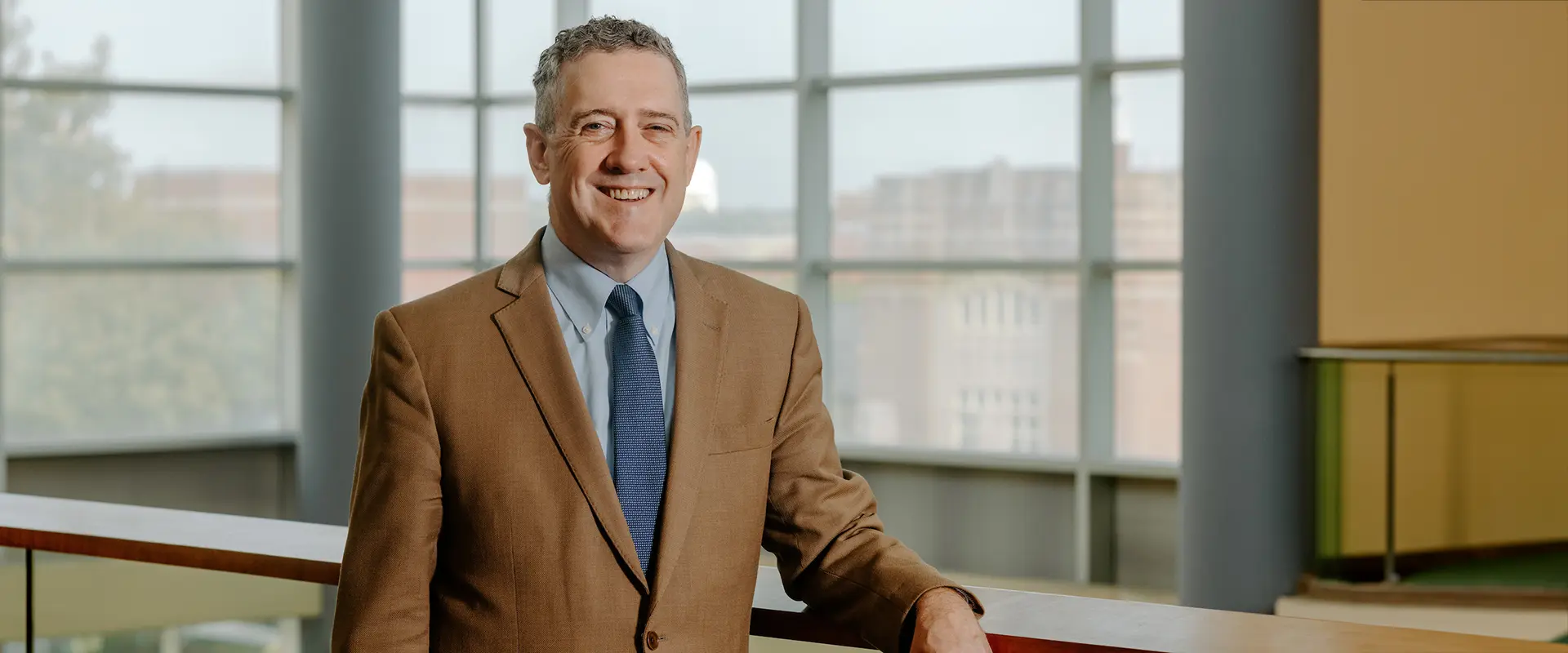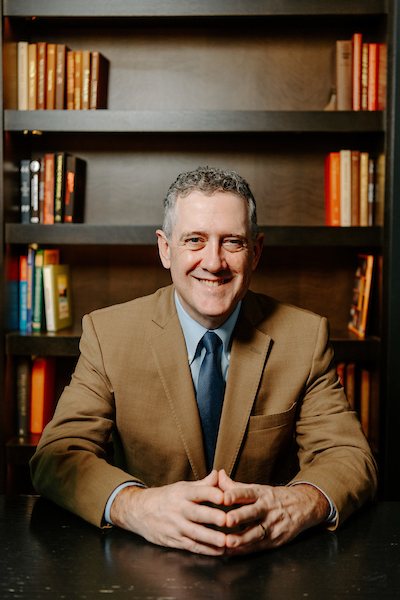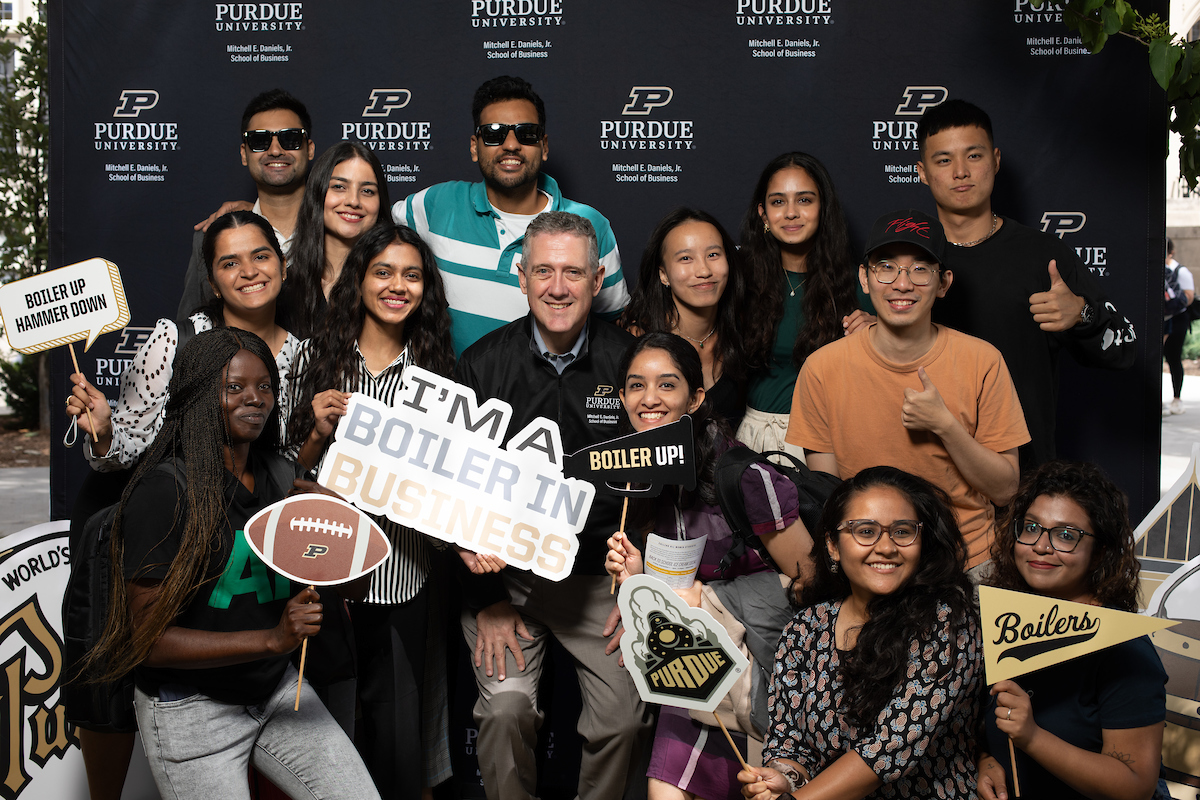
He’s biked through much of Europe, built a Spotify playlist dominated by bossa nova music, and played pickup basketball against former Minnesota Golden Gopher and NBA legend Kevin McHale. He’s also had a stint as the longest-serving president of Federal Reserve Banks and is considered one of the most respected economists in the country.
Now, Jim Bullard is taking on a new challenge. On August 15, he officially became the Dr. Samuel R. Allen Dean of Purdue’s Mitchell E. Daniels, Jr. School of Business. His task is to carry out the vision for the reimagined business school as a highly ranked tech-driven, analytics-based program grounded in the principles of a free market economy.
“I like the technical aspect of Purdue and its prowess in engineering,” Bullard says. “I view my research in economics at the crossroads of engineering and economics. A lot that I’ve worked on has been based on appropriating ideas out of the engineering literature and applying them to the economics literature.
“So, to me, the connection with engineering and bringing the business school even closer than it already is with the engineering program is just the right sort of high-level strategy that we need.”
Bullard was chosen following a national search led by a Transition Steering Committee co-chaired by Kevin Mumford, Kozuch Director of the Purdue University Research Center in Economics, and Gary Lehman, vice chair of the Purdue Board of Trustees. In the end, he earned a unanimous vote from the committee.
“We are thrilled to have Jim Bullard leading the transformation of the Daniels School of Business,” Lehman says. “We evaluated many fantastic candidates during this process, but Dr. Bullard’s exemplary record as a scholar and business leader cemented him as our top choice.”
Bullard was born in Columbus, Wisconsin, but his family moved to Forest Lake, Minnesota, just north of the Twin Cities. He and his friends could ride their bikes around the lake almost anywhere in town, which he says gave him a “great deal of freedom” and spurred his lifelong interest in cycling.
He joined his buddies at Williams Arena to watch the Gophers play, with stars like McHale, Mychal Thompson and Ray Williams. They would buy cheap tickets high in the arena and gradually work their way down to courtside.
Bullard played basketball and ran cross country in high school. He also took an economics class that would help shape his future.
“I think the logic of economics appealed to me in a broad way. I was exposed to the ideas of what determines prices, how supply and demand works, and other things I hadn’t really thought about,” he says.
Bullard stayed in the state for his undergraduate degrees, both in economics and quantitative methods and information systems, from St. Cloud State University. It was there that he met his wife, Jane Callahan. After working a year at State Farm Insurance in Bloomington, Illinois, he and Jane decided to both earn doctorates at Indiana University. The summer before they left, the couple went on a long bike trip through Europe, hitting stops in Holland, Germany, Italy, France, Ireland, Wales and England.

With a doctorate in hand in 1990, Bullard accepted a position as an economist in the research division at the Federal Reserve Bank of St. Louis. He worked his way up to vice president and deputy director of research for monetary analysis, earning a stellar reputation for research and thought leadership in the process.
In 2008, he was named president and chief executive officer. He spent 15 years in that role, becoming the longest-serving Federal Reserve Bank president in the country. While serving on the Federal Reserve’s Open Market Committee, macroeconomic advisers named him the FOMC’s second-biggest mover of markets in 2010, behind Chairman Ben Bernanke, and the biggest mover of markets in 2011 and 2013. In 2014, The Economist ranked him as the seventh-most influential economist in the world.
He also built the culture of his organization despite taking over at a time when the Fed was in one of the biggest crises of its 100-year-plus history.
“Culture eats strategy,” Bullard says. “I try to be inclusive and get advice from a wide variety of sources. We had a good management team, but you have to stay at it every day and make sure they’re working on the things you think they’re working on, and that you’re of one mind about what needs to be done next.
“We worked on talent development and talent management, so that when people did leave or retire, we had a good pipeline for the next person to come in and do a good job for us. We sometimes hired from the outside, and I do like that because sometimes I think it brings fresh ideas and new blood into the organization.”
Another key to success was eliminating silos.
“We tried to get to a strategy that was coherent to everybody in the organization so that everyone could see themselves in the strategic plan, even if they didn’t quite know exactly what everyone else was doing. We wanted to find synergies where we could between different parts of the organization,” he says.
“The goal was to make people see job opportunities elsewhere in the organization. Even though they might be blocked where they were, they might be able to move somewhere else and get a promotion.”
“Make sure first to do no harm. Don’t disrupt something that’s working perfectly well. Then embark on a course where you’re relentlessly pursuing a strategy to get better at each step.”
His efforts were noted. The St. Louis Post-Dispatch named Bullard the Top Workplace Leader among the region’s large employers in 2018.
That’s not to say that the job didn’t come with stress. Bullard and his colleagues were cognizant of the impact their work would have on people leading everyday lives.
“Macroeconomics rules the world,” he says with a smile. “You feel responsible for policy. Some things can be handled by staff, but some things only accrue to the person who’s in charge.”
Listen to some of Dean Bullard's bossa nova favorites on Spotify:
To offset the stress, Bullard learned to relax with music, often retreating to his soothing bossa nova playlist with a little jazz mixed in. He’s continued to bike and says he enjoys the trails around West Lafayette. He’s also maintained an interest in sports, particularly football, and he and Jane try to make time to visit their adult daughters; Eleanor works with a nonprofit in Minneapolis and Maddie is a lawyer in Denver.
Bullard is assuming the deanship at a time when the Daniels School intends to rise to the next level by substantially growing both faculty and staff, expanding experiential opportunities for students, and strengthening the school’s connection to technology. He plans to lean on the talents of faculty and staff to help make it happen.
“I encourage people to innovate,” Bullard says. “That was a big part of being at the St. Louis Fed. It’s important in an organization that doesn’t have a bottom line. It’s incumbent of the management team to incentivize innovation, because it doesn’t happen as naturally as it might happen in the private sector.”
Bullard became a media favorite during his time at the St. Louis Fed, and that has continued in his role at Purdue. In his first month, he did media interviews with several outlets, including Reuters, Yahoo! Finance, CNBC, Bloomberg TV, and The Wall Street Journal.
His expertise is also being tapped across campus. Bullard serves as a special advisor to Purdue President Mung Chiang.

In the short term, though, he says his focus is to listen and observe.
“I think any time when you come into a new job like this, you have to understand the current state and understand how things get done. Make sure the trains are running on time and make sure first to do no harm. Don’t disrupt something that’s working perfectly well,” he says.
“There may be a few things that need immediate attention, but then embark on a course over a longer period of time where you’re relentlessly pursuing a strategy to get better at each step.
“And I think we’ll be able to do that and have great success here.”